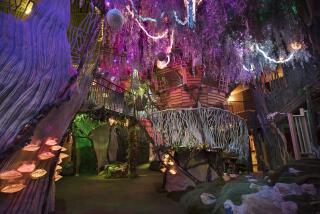How ‘Wolfwalkers’’ filmmakers pushed the expressive potential of hand-drawn animation
Robyn Goodfellowe is not afraid of wolves. And despite the strict rules that govern her new life in a new town, she just wants to go out hunting with her father.
After sneaking outside the walls of Kilkenny, Ireland, with her trusty falcon and crossbow, Robyn quickly learns she isn’t as prepared for the realities of the task as she believed. Leading the pack of wolves that reside in the forest are Mebh Óg MacTíre and her mother Moll — the last of the magical Wolfwalkers. And meeting Mebh changes Robyn’s opinions about wolves forever.
According to directors Tomm Moore and Ross Stewart, the central elements of “Wolfwalkers” came together quickly. Around seven years ago, after the longtime friends directed a segment of “The Prophet” (2014) together, Moore asked Stewart to codirect his next feature.
“I knew I wanted to do one final piece in the Irish folklore space, exploring [those] themes,” said Moore, referring to his now-triptych of films that also includes 2009’s “The Secret of Kells” and 2014’s “Song of the Sea” from Irish animation house Cartoon Saloon. “So I asked him to spend time just helping me come up with what that might be, because there was a lot of different options.”
The oft-maligned wolf gets a redemption tale in Tomm Moore and Ross Stewart’s enchanting animated adventure “Wolfwalkers,” which is headed to Apple+ after a theatrical run.
From their earliest brainstorming session the pair turned to topics they were passionate about, such as animal rights, speciesism and extinction. They were also concerned about the political climate, which has only become more extreme since then.
“We were worried about the world becoming more and more polarized,” said Moore. “We were comparing it to Northern Ireland and the [divide between] Catholics and Protestants … and that all started way back in the 1600s with [Oliver] Cromwell invading Ireland.”
Part of the English leader’s legacy is how he worked to rid Ireland of wolves. Whatever the practical motivations, wolves once thrived on the island and are prominent in Irish folklore, so wiping them out was symbolic of his conquest. This history is reflected in “Wolfwalkers” through the tyrannical Lord Protector, who is understood to be Cromwell although his name is never mentioned.
“Wolves were the last megafauna in Ireland to go completely extinct,” said Stewart. “With the extinction of wolves, so much of a connectedness to that animal is also gone from our society. You’re not just losing the animal, but you’re also losing a whole part of human culture and human society with it. And once it’s gone, it’s gone forever.”
One key detail that changed between the earliest version of the story and the completed film is Robyn: Originally, the character had been envisioned as a boy. Having already “done the brother-sister thing” in his previous movies, Moore said the plan was to explore a first friendship or a first crush dynamic with Robyn and Mebh. But the setup didn’t quite work.
“We wrote a whole draft with Robyn as a boy, and it wasn’t working,” said Moore. “We were confused [about] why it wasn’t working. We were constructing conflict, stuff for the little boy to come up against. We had to construct all these obstacles for why he wasn’t allowed out. It made so much more sense for him to be a little girl.”
With “a girl, then it’s not just going to be [her father] saying ‘You can’t be a hunter,’” said Stewart. “All of society, especially this Puritan overlord society, would be like, ‘No, a girl’s place is inside doing dishes and making food and looking after the kids.’”
The adjustment, which came at the suggestion of others in the studio, helped smooth out the story and also changed the character of Robyn and Mebh’s relationship. When Robyn meets Mebh, she is meeting her counterpart — a reflection that lets her really see an alternative to her stifling life.
According to Moore, one unforeseen result of having a girl Robyn is the queer subtext present in the film.
“The [film] editor at one point said, ‘This is a coming out story — this could be a real first crush, queer romance’ … [and] reinterpreted the whole movie,” said Moore. “We didn’t lean into it, but we were aware it was there. It was kind of gratifying to see that some people saw that.”
In addition to its themes and story, Moore and Stewart had started developing the visual elements of “Wolfwalkers” from the beginning.
“Even on that very first session where we came up with the bones of the story, we were already drawing characters and we were already drawing key moments,” said Stewart. “As soon as we get a story in our head, we immediately would get certain visuals of that story. Key moments [like] Robyn on the back of Moll or Mebh breaking out of a cage.”
Among the film’s artistic inspirations was Isao Takahata’s “The Tale of Princess Kaguya,” which was nominated for an Academy Award in the same year as Moore’s “Song of the Sea,” and its use of expressive line drawing.
“That was an idea that we wanted to do, and we made it part of the story,” said Moore. “The English and everyone who lives in the town are like a woodblock print [with] thick, black clean outlines. And then, the more that Robyn became part of the forest, the more her lines would change to be like Mebh and the wolves who are really scratchy” with visible underdrawings.
This approach was to emphasize how these are hand-drawn characters and that the film is indeed composed of actual drawings.
“In all animated films, there’s so much craft and so much artistry that goes into it,” said Stewart, who also noted how as artists they don’t just look at other animated films for inspiration. “Some of the backgrounds that are flashing by in half seconds, took artists a week to make.”
And “Wolfwalkers” pushed its artistry even further through its use of “wolfvision,” a different visual mode to represent how wolves see the world. One of the key messages of the story relates to the importance of seeing things from someone else’s point of view. For Robyn, this involves transforming into the creatures she had intended to hunt to actually see the world the way they do.
Developed with experimental animator Eimhin McNamara, “wolfvision” is more than just vision — it also conveys scent and affects the sound and “it was much more immersive than anything we’ve done before,” said Moore.
Stewart said that he was particularly interested in pushing expressive animation in addition to visual language with “Wolfwalkers.”
If “you can do a painting that can express joy, that can express sadness, that can express anger just in mark-making and color and visual line,” said Stewart. “Then you can also imply that into your animated feature as well.”
“Anything that can be made visually can be animated. Like, if you do a painting, you can animate paintings. Stop-motion is basically animating sculptures. Anything visual can end up onscreen and end up moving. So once you realize that, then you’re open to the whole gamut of expressive art forms.”
More to Read
Only good movies
Get the Indie Focus newsletter, Mark Olsen's weekly guide to the world of cinema.
You may occasionally receive promotional content from the Los Angeles Times.











